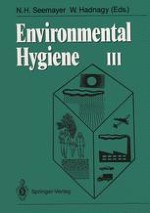1992 | OriginalPaper | Buchkapitel
Studies on the exhalation of volatile N-Nitrosamines following systemic application to Sprague-Dawley rats
verfasst von : P. Schmezer, B. M. Schmezer, B. L. Pool-Zobel, R. G. Klein
Erschienen in: Environmental Hygiene III
Verlag: Springer Berlin Heidelberg
Enthalten in: Professional Book Archive
Aktivieren Sie unsere intelligente Suche, um passende Fachinhalte oder Patente zu finden.
Wählen Sie Textabschnitte aus um mit Künstlicher Intelligenz passenden Patente zu finden. powered by
Markieren Sie Textabschnitte, um KI-gestützt weitere passende Inhalte zu finden. powered by
Specific volatile N-nitrosamines (e.g. N-nitrosodimethylamine, NDMA) have been detected in different sources of the human environment, such as in tobacco smoke (Tricker and Preussmann, 1989) or in several work places (rubber, leather, chemical industries; ECETOC, 1990). In these exposure situations, amounts of up to several hundred micrograms per cubic metre have been found. For this reason, we initiated a long-term inhalation study with NDMA in Sprague-Dawley rats using exposure schedules in which the lowest concentration was comparable to peak concentrations at those work places (Klein et al. 1991). It is feasible to make risk assessments on the basis of such inhalation experiments with animals at dose levels relevant to the human situation. For this purpose, it is furthermore important to know the actual absorption rate in the respiratory tract. Therefore, in addition to the longterm assay, several short-term experiments were performed to study the exhalation rate of NDMA and some other volatile N-nitrosamines in rats. In earlier inhalation experiments with endotracheally intubated rats, we had shown that some volatile nitrosamines including NDMA are not completely absorbed in the respiratory tract and several % of the nitrosamines inhaled for a few minutes were exhaled again within the subsequent hour (Klein and Schmezer, 1984).
